This post is part of a larger deep dive
Curious about the role of the infinite universe in Another Earth? Check out Another Earth Explained!
Or read the full Another Earth article!
This post is part of a larger deep dive
Curious about the role of the infinite universe in Another Earth? Check out Another Earth Explained!
Or read the full Another Earth article!
Director: Mike Cahill
Producer: Hunter Gray, Mike Cahill, Brit Marling, Nicholas Shumaker
Writer: Mike Cahill, Brit Marling
Starring: Brit Marling, William Mapother
Year: 2011
Duration: 1h 32 m
Country: U.S.A.
Language: English

Our rating

Your rating
While I was zapping through my ludicrously tiny film library, I came across a film called “Another earth”, and I thought to myself, “Well, why not entertain myself with a good old Sci-Fi film to realise how precarious our existence really is”.
I have seen a LOT of Sci-Fi films in my time, and was expecting another corny over the top disaster film.
I was wrong.
Another Earth was, in fact, quite thought-provoking. Granted, if you are only thrilled with stories about green, oversize-eyed, tiny-waist ETs destroying earth, simply live to see Margot Robbie in Yoga tights or Ryan Gosling shirtless, or are looking for inspiration for a PhD in astrophysics, then this film is probably not for you.
If, on the other hand, you don’t mind watching an indie film with an engaging story that will make you think twice next time you look into the sky, then why not giving this film a go.
Brit Marling plays Rhoda, a bright teenager, who will soon enter MIT to begin her studies in astrophysics. After attending a party, an inebriated Rhoda drives home and is momentarily distracted with the sight of a recently discovered planet that has been approaching Earth.
She crashes into another car, killing a woman and a boy, and leaving a man in a coma. After serving a jail sentence of 4 years, Rhoda struggles adjusting to her new life and decides to work as a janitor in a school, in order to keep interactions with people to a minimum.
She eventually learns that United Space Ventures (a private company run by a billionaire) is offering a trip to Earth Two, and she decides to participate. She also hears about the man in the accident who had awakened from his coma. Out of guilt, she concots a story about a trial cleaning and offers to clean his house. The two start to get along well, and have a brief romantic relationship.
“Another earth” has the peculiarity of most indie films, which look as though somebody is walking around with a camera, following the characters every move. It certainly gives the film a more intimate, if not surreal, ambience, which I quite enjoyed.
The acting was very good indeed: I thought Brit Marling’s acting, in particular, was spot-on. The inner struggle that her character experiences and the guilt that gnaws away at her confidence really transpires in the movie.
Alas, even though I did like the film, I have to admit that I was disappointed that the scientific treatment of the origin of Earth Two was barely nonexistent.
For instance, there was no real attempt to explain why astronomers hadn’t spotted another earth, which has only a radius of about 6350 km, plunging towards earth.
Or, perhaps more importantly, what the consequences of having another planet a few thousand kilometers from us really were. As it turns out, having another planet orbiting earth would not arouse any curiosity of any kind, because we would all most probably be, well…, dead.
First things first: you should know that geophysics isn’t really my forte, so apologies if my explanation sounds way oversimplified.
Let’s first try to understand how the Moon affects events on Earth, before we tackle the problem of having another equally-sized planet orbiting Earth.
I’m sure you have heard that the Moon is responsible for governing the tides on Earth (the Sun has also a noticeable influence but for the sake of simplicity let’s just focus on the Moon). How does that happen?
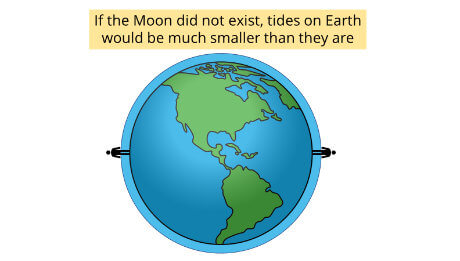

Well, the Moon is attracted to Earth, but Earth is also attracted to the Moon. Think of the Moon trying to pull Earth via invisible strings, and the strings are connected to both the continents and oceans.
In the place where the Earth is closest to the Moon you will see a big bulge forming. However, because water is way easier to displace than solid stuff like continents, the bulge will mainly consist of water. If you happen to be on a beach when the Moon is directly overhead, then you will experience a high tide.
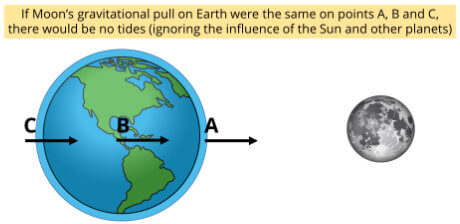
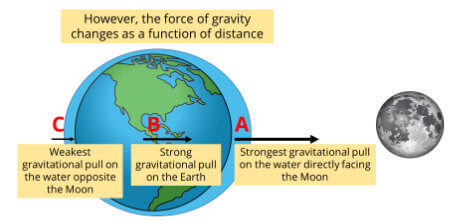
Now, someone standing on a beach on the opposite side of Earth will also see a high tide forming there, albeit smaller than the high tide directly facing the Moon.
It may sound counterintuitive, but think of it the following way.
Imagine 3 points on earth along a horizontal line (see the figure on the right above): point A is directly facing the moon, point B is at the center of the Earth, and point C is on the other side of Earth.
Point A will experience a lot of gravitational pull from the Moon. Point B will experience a little less gravitational pull from the Moon. Point C will experience the least gravitational pull from the moon. Why? If gravity was constant A, B and C would feel the exact same pull (see the figure on the left, above). But gravity isn’t constant over planetesimal distances – it gets weaker with distance. That’s why C will have the least pull from the Moon.
So, from the perspective of someone standing on the side opposite the moon, the water level will seem to increase because Earth’s crust on that side is being pulled slightly more strongly towards the moon than the surface of the water.
This is the reason why you have two tides per day – if you are in Greece when the moon is directly facing you, you will have a high tide. The Earth then rotates around it’s axes, and 12 hours after, Greece is on the other side and you will experience the second (slightly smaller) high tide.
Although I depicted it as such (for ease of visualisation), you should not think of the bulges as the result of the Moon pulling water towards it. It’s slightly inaccurate.
In fact, water from the oceans is sort of being “squeezed” towards the Earth-Moon line and piling up there.
This is pretty much like squeezing a pimple.
Imagine you were to change the size of the Earth to the size of a round doughnut with chocolate filling. If you gently squeezed the doughnut at the center, the filling would bulge outwards on both sides of it. The dough of the doughnut (the continents) also feel this pressure, but remain in pretty much the same place. The filling (oceans) is much more easily displaced.
Check out this video for a clear explanation of the phenomenon:
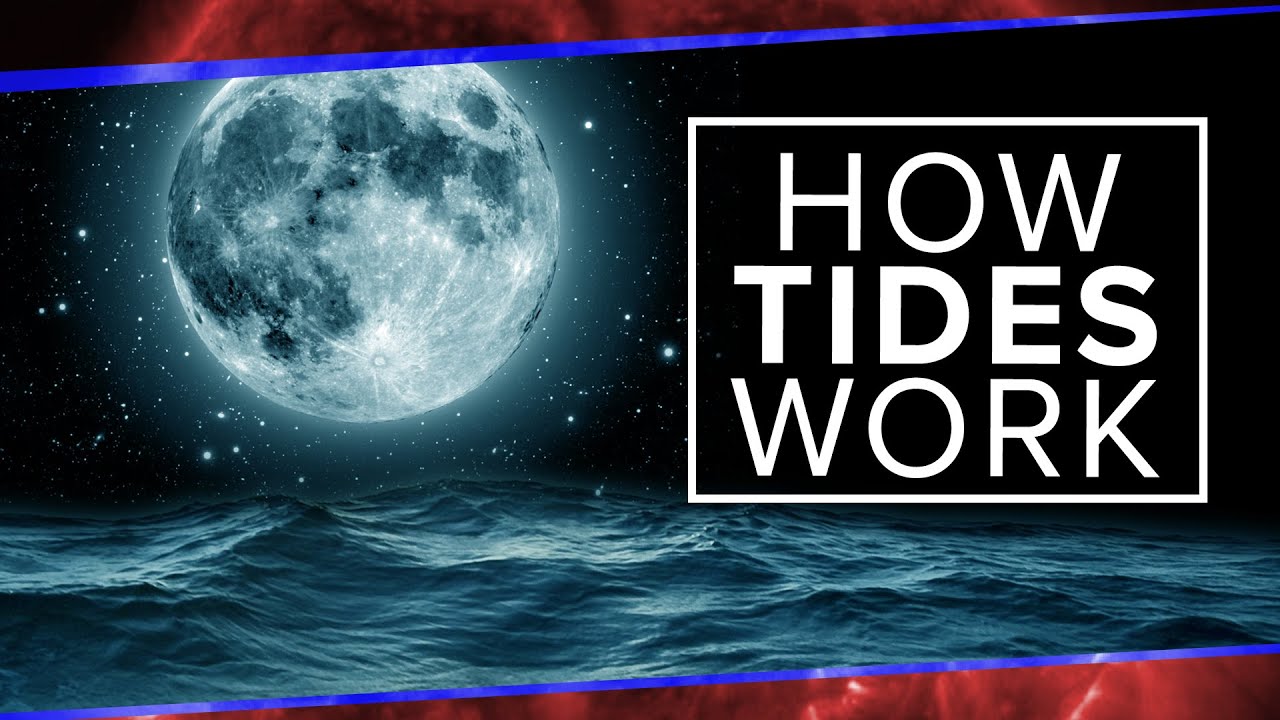
By the way, if you are concerned to go the toilet when the moon is right above you, don’t worry about water shooting out of the toilet due to the tidal force (although I should mention that in Japan they have toilets where you push a button and a jet of water sprays right off).
To be accurate, the Moon actually creates a tidal force on the water in your toilet, but because there are so few water molecules in comparison to the vastness of the ocean, the pull is really insignificant compared to the Earth’s gravity pulling them down, so they are kept where they are.
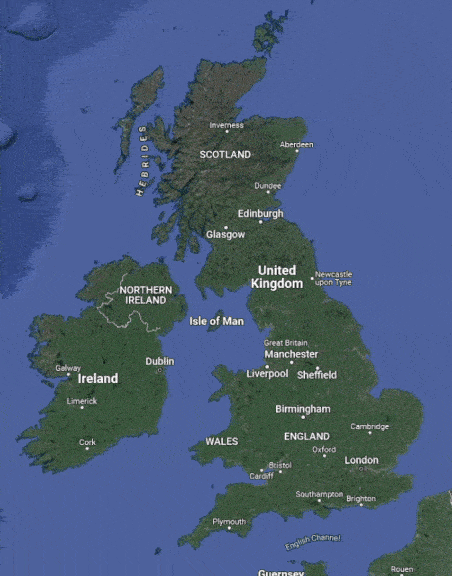
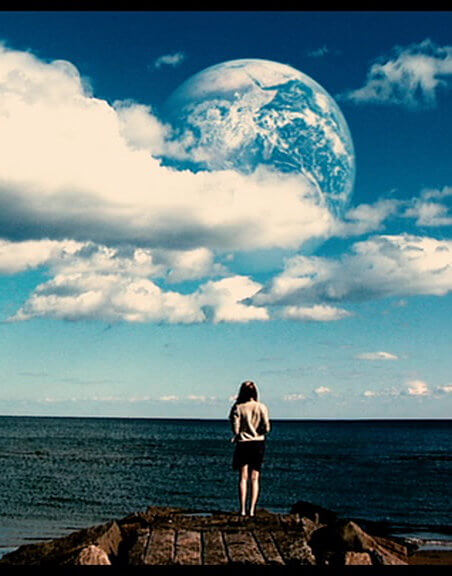
I think you can see where this is going. The Moon is about 4 times smaller than Earth, but is able to significantly govern tides on Earth.
So, if the Moon were to increase to the size of Earth, the tidal bulges would increase so dramatically that it would give rise to enormous tides. By enormous I mean ENORMOUS; big enough to submerge most coastal cities, and probably even entire countries such as the Bahamas and/or Cuba.
In other words, our Earth would be a terrifying place to be. So, the scene where Rhoda drives to the coast and stares at the ocean with Earth Two floating above her? Not happening!
Aside from the huge tides, which alone would be such a catastrophic event as to place humanity in great peril, they wouldn’t be the only effect that Earth Two could cause on our Earth. Here is a non-exhaustive list of catastrophes:
1. Earthquakes would be much more frequent due to stronger tidal effects on earth’s crust.
2. Earth’s rotation would slow down to the point that both Earths would always be seeing only one side (this is called tidal lock). When this happened, the water level would become stationary and there would be no tides (or a permanent “high tide” on the side facing Earth Two, and permanent “low tide” on the side opposite Earth Two).
3. One day would have more than 400 hours (our Earth hours). This means that the side facing the sun would have hundreds of hours of continuous sunlight, but it also means that the opposite side would experience hundreds of hours of darkness.
4. Day-night temperatures changes would be so drastic that most animal species would perish.
5. There would be significant disruptions to the magnetic field, so the risk of radiation poisoning would be a real danger.
6. Your weight would change considerably dependening on whether you were on the side facing Earth Two (you’d be heavier) or the opposite side of it (you’d be lighter). Not sure how humans would cope with that.
7. Of course, arable land would become extremly scarce, so famine would run rampant.
8. There would be a risk of atmosphere evaporating into space on the side opposite Earth Two, making it much harder for humans to breathe.
Second, the online draw for a visit to Earth Two was a bit illogical. I mean, I am fairly certain that world leaders would agree that the first expedition to an inhabited planet should be pioneered by only the most qualified of astronauts that have had extensive training in space, as well as the bloody guts to embark on a mission like this.
But no, you only really need to write a short precis of why you think you should be selected. What’s more, allowing to give your winning ticket to another person would most certainly be a recipe for disaster.
It’s understandable that the creative team did not wish to get bogged down in the scientific details, as this isn’t a science fiction or a natural disaster film, but, instead, the focus is on the drama of Rhoda’s life.
Still, the almost lack of scientific explanations was very off-putting to me. There have certainly been films that got this fairly right.
Take the comedy Bruce Almighty, starring Jim Carrey and Jennifer Anniston for example. There is a scene where Bruce pulls the moon closer to Earth as part of his plan to seduce Grace. The next day was met with cataclysmic hurricanes, earthquakes and whatnot.
Surely, there would have been ample opportunities to incorporate these aspects into the script of “Another Earth” without necessarily having to make it a major theme in the movie.
In general, I recommend the film. Sure, the evident scientific inaccuracy was a constant nagging feeling, but Rhoda’s struggle was moving and I think the acting was generally very good. Another Earth gets a rating of 3 stars.
The film moves at a slow pace, dialogues are mostly laconic and the intimacy with which the camera’s follow Rhoda’s life, give the film a slightly eerie mood.
However, Another Earth isn’t a weird film. Setting aside the ambiguity of the last scene (when Rhoda meets her doppelgänger), not much requires an explanation.
For this reason, Another Earth gets a Bizarrometer score of 1.
If you exclude the last scene, Another Earth is quite simple to understand. In fact, the reason that probably led you to this article is to understand why Rhoda from Earth Two (henceforth, Rhoda 2) visited Rhoda from Earth One (henceforth, Rhoda 1).
I’m sad to say that there isn’t enough information in the movie to answer this question with confidence.
But one thing is certain: the accident that sent Rhoda 1 to jail has likely only happened on Earth One.
According to a popular theory, the so-called Broken Mirror Theory, synchronicity of events between the two Earths was broken as soon as the two Earths got a glimpse of each other. That appeared to have happened a few days before the fatal accident that killed John’s wife and son. So, life on Earth One took a completely different course than life on Earth Two.
It’s also safe to assume the competition on Earth Two to visit Earth One did not take place.
First, the encounter between Rhoda 2 and Rhoda 1 happens four months after John from Earth One (henceforth, John 1) departed to Earth Two. Since the two Earths are technologically equivalent, why didn’t Earth One receive inhabitants from Earth Two at about the same time?
Second, since the accident on Earth One did not happen on Earth Two, Rhoda 2 and John from Earth Two (henceforth, John 2) never met. Without the emotional story that won Rhoda 1 the competition on Earth One, Rhoda 2 would likely never have been selected.
Still, Rhoda 2 did travel to Earth One, so why did she do it?
My guess is that Rhoda 2 finished her degree in MIT and became a successful astrophysicist – pay attention to how elegant Rhoda 2 is dressed, a potential sign that she is well-off.
I would venture to say that she is on Earth One on her own accord; possibly on a covert mission. I know, this is starting to sound like a plot for a conspiracy film, but, otherwise, why wouldn’t Rhoda 1 have heard in the news of a landing from Earth Two?
Maybe John 1, upon arriving on Earth Two, sought Rhoda 2 to tell her the story of Rhoda 1 back on Earth One.
During the film, Rhoda is seen to be a very sensitive and compassionate woman. Maybe Rhoda 2 felt it would be the right thing to do to give support to her doppelgänger.
Before expanding on this interpretation, I’ll describe some fascinating facts about the universe which will (hopefully) blow your mind, the way mine was blown.
Great article! A question is the rotation of Earth 1 and Earth 2, and what they see of each other because of their different positions in relation to the Sun. I guess Rhoda 2 could not see Earth 1 (lit by the sun) through her car window and therefore did not cause the accident.
Hi Andreas,
Yes, that’s a very good observation!
Indeed, I agree that Rhoda 2 couldn’t possibly have been looking at Earth One at the time of the accident. For that to happen, the American continent of each Earth would have to be facing each other, and that would imply that the American continent of Earth Two had to be facing the sun, in which case Earth One wouldn’t be visible at all.
I mentioned somewhere in the article that synchronicity probably broke as soon as Earth One inhabitants caught sight of Earth Two, and that must have happened way before the accident.